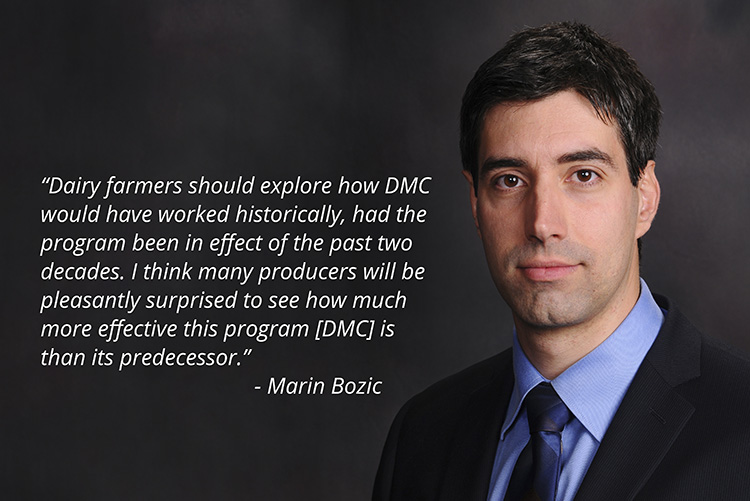Archived Content
This blog was published more than three years ago and is considered archived. It is not actively updated and may not reflect current policies or practices. However, some of the content may still be useful.
In this Ask the Expert, Marin Bozic answers a few questions about USDA’s Dairy Margin Coverage program. Marin is an assistant professor in the University of Minnesota’s Department of Applied Economics, where he conducts research on dairy risk management and dairy policy, and teaches undergraduate courses on agribusiness finance, risk management, and financial modelling.
The DMC program offers reasonably priced protection to dairy producers when the difference between the all-milk price and the average feed cost (the margin) falls below a certain dollar amount selected by the producer. The deadline to enroll for 2021 coverage is Friday, December 11, 2020.
Marin, along with Dr. Mark Stephenson at University of Wisconsin-Madison, partnered with USDA to upgrade the DMC dairy decision tool to help producers choose a level of coverage that fits their unique risk management needs.

1. What are the benefits of the Dairy Margin Coverage Program?
I have researched Farm Bill programs for dairy for over ten years and found that the DMC program is a significant upgrade over previous programs. My research suggests that the program has the potential to deliver effective risk protection for dairies with herd sizes up to 250 cows, and partial risk protection for larger dairies. In addition to researching this topic, I have worked with Dr. Mark Stephenson to redesign the DMC dairy decision tool focus it on program aspects that are most critical for making informed sign-up decisions.
Had DMC been in effect since 2015, producers enrolled at the $9.50 coverage level would have seen payments net of premiums in the range of $1.00 per hundredweight on enrolled milk. Over the last fifteen years, payments would have exceeded premiums in all years other than 2014, which most producers will remember as a year with exceptionally strong milk prices. The program is cash-flow friendly. Payments are frequent during spring months, when margins are typically lower, but the program premiums are not due until September.
2. How did DMC impact producers who enrolled in 2020?
In 2020, the DMC program made substantial payments for April and May, at the onset of the COVID-19 crisis in the United States. In April, actual margin was $6.03 per hundredweight, and in May the margin was $5.37 per hundredweight. That means that a producer who has 5 million pounds covered for 2020 at $9.50, would have seen a total payment in 2020 equal to $31,667, against a premium of $7,500. Payment net of premium for the entire 2020 will average $0.50 per hundredweight for enrolled milk.
3. Why is it important for dairy producers to enroll for 2021? What are some of the trends you are seeing for the next year?
While there has been positive news about COVID-19 vaccine development, we do not expect out-of-home food consumption to return to normal until at least summer 2021. In contrast, milk supply is growing strongly, and new cheese processing capacity is in the process of being commissioned in Michigan and some other states. All leading industry analysts are very concerned about the first half of 2021. Furthermore, global macroeconomic outlook is not very optimistic at this point, as COVID-19 effects are dampening growth projections in many countries. Of course, everyone hopes for the best, but we do not use risk management for the best-case scenario, but to shield us from an adverse drop in prices. DMC offers excellent value-for-money to dairy producers, and if the 2021 feed costs materialize at the level where they are projected to be, then $9.50 coverage would trigger payments when the U.S. all-milk price falls below $17.50 to $18.25 per hundredweight. Historically, the Class III milk price was about $1.40 below the U.S. all-milk price, so $9.50 coverage would correspond to an approximate Class III milk price floor of $16.10 to $16.85.
4. What is the value of the Dairy Margin Coverage tool and why should producers use it?
Dairy farmers should explore how DMC would have worked historically, had the program been in effect over the past two decades. I think many producers will be pleasantly surprised to see how much more effective this program is than its predecessor, the Margin Protection Program.
With the tool, producers can see how different coverage levels correspond to milk price floors given the projected feed costs. For example, while $9.50 coverage corresponds to $17.50 to $18.25 per hundredweight all-milk price payment trigger, electing the $4.00 coverage level sets the all-milk price payment triggers below $13.00 per hundredweight, which is far too low to be truly helpful.
5. Is there anything else you would like to share with dairy producers that might help them navigate their risk management decisions?
Dairy producers should keep in mind that DMC can be combined with other USDA risk management programs for dairy, such as the Livestock Gross Margin for Dairy Cattle and Dairy Revenue Protection. Producers can “stack up” these programs to cover production not covered through DMC.
More Information
For more information on the program and how to enroll, visit the DMC webpage, or contact your local USDA Service Center.
Lauren Moore is a public affairs specialist for USDA’s Farm Production and Conservation Business Center.


